Thermal and Mechanical Properties of Nano-Carbon-Reinforced Polymeric Nanocomposites: A Review
Abstract
:1. Introduction
2. Graphene-Based Nanocomposites
3. MXene-Based Nanocomposites
4. Carbon-Nanotube-Based Nanocomposites
5. Carbon-Black-Based Nanocomposites
6. Carbon-Quantum-Dot-Based Nanocomposites
7. Fullerene-Based Nanocomposites
8. Metal–Organic Frameworks Based Nanocomposite
9. Summary and Outlook
10. Future Perspectives
Author Contributions
Funding
Data Availability Statement
Acknowledgments
Conflicts of Interest
List of Abbreviations
| CNTs = Carbon nanotubes | CB = Carbon black |
| CQDs = Carbon quantum dots | SWCNTs = Single-walled carbon nanotubes |
| MWCNTs = Multi-walled carbon nanotubes | 2D = Two-dimensional |
| 1D = One-dimensional | 0D = Zero-dimensional |
| GO = Graphene oxide | rGO = Reduced graphene oxide |
| PMMA = Poly methyl methacrylate | MMA = Methyl methacrylate |
| PVA = Polyvinyl alcohol | PVDF = Polyvinylidene fluoride |
| MFC/NFC = Micro- and nano-fibrillated | FTIR = Fourier transform infrared |
| cellulose | LOI = Limiting oxygen index |
| CNC = Cellulose nanocrystal | PF = Phenol formaldehyde |
| PiP-DOPO = Piperazine | PNMTh = Poly N-methylthionine |
| DOPO-phosphonamidate | NaCMC = Sodium carboxymethyl cellulose |
| HQ = Hydroquinon | CMC = Carboxymethyl cellulose |
| GPOSS = Glycidyl isooctyl polyhedral | PET = Polyethylene terephthalate |
| oligomeric silsesquioxane | PCL = Poly caprolactone |
| PBT = Polybutylene terephthalate | FGO = Functionalized graphene oxide |
| PU = Polyurethane | SME = Shape memory effect |
| SMPNCs = Shape memory polymer | TPU = Thermoplastic polyurethane |
| nanocomposites | MNH = MXene nanoscale hydrogel |
| Zr-AMP = Zirconium | MNOH = MXene nanocomposite |
| amino-tris-(methylene phosphonate) | PPDA = Phenyl phosphonic diamine hexane |
| PLA = Polylactic acid | MCA = Melamine cyanurate |
| PP = Polypropylene | NBR = Nitrile butadiene rubber |
| NR = Natural rubber | PSS = Polystyrene sulfonate |
| CNTPN = Carbon nanotube polymer | CPNC = Carbon polymer nanocomposite |
| nanocomposites | PDA = Polydopamine |
| FCNTPN = Functionalized carbon | HDPE = High-density polyethylene |
| nanotube polymer nanocomposites | DDA = Dodecyl amine |
| ICNTPN = Intact carbon nanotube | MCNTs = Melamine carbon nanotubes |
| polymer nanocomposites | SENB = Single-end notch bend |
| PNCs = Polymer nanocomposites | PCNT = Polymer carbon nanotube |
| GSD = Graphic structure design | CFRPs = Carbon-fiber-reinforced polymers |
| GIc = Mode I interlaminar fracture toughness | FMLs = Fiber metal laminates |
| GFRPs = Glass-fiber-reinforced polymers | ABS = Acrylonitrile–butadiene–styrene |
| SBR = Styrene-butadiene rubber | IPN = Interpenetrating polymer network |
| IIR = Butyl rubber | PE = Polyethylene |
| EPDMn = Ethylene propylene diene monomer | CF = Carbon fiber |
| CVD = Chemical vapor deposition | ILSS = Interlaminar shear strength |
| IFSS = Interphase shear strength | PVC = Polyvinyl chloride |
| XNBR = Carboxylated acrylonitrile | PEO = Polyethylene oxide |
| butadiene rubber | NHS = N-hydroxy succinimide |
| EDC HCl = Ethyl carbodiimide hydrochloride | WPU = Waterborne polyurethane |
| ECNFs = Electrospun carbon nanofiber textiles | CR = Chloroprene rubber |
| CGQDs = Coal-based graphene quantum dots | fPA = Aromatic polyamide |
| N-CQDs = Nitrogen-doped carbon quantum dots | D-A = Diels–Alder |
| EUR = Eucommia ulmoides rubber | SPEI = Sulfonated polyetherimide |
| PEPA = Polyethylene polyamine | ED = Epoxy diane |
| FRPNs = Fullerene-reinforced polymer | PC = Polycarbonate |
| nanocomposites | MD = Molecular dynamics |
| PLLA = Poly-L-lactic acid | ZIF-8 = Zeolitic imidazolate framework-8 |
| SBR-nAl = Styrene-butadiene rubber | CNF = Carboxylated cellulose nanofibers |
| nano-alumina | SPE = Solid polymer electrolytes |
| MOFNF = Metal–organic framework nanofibers | CA = Cellulose acetate |
References
- Fu, S.-Y.; Sun, Z.; Huang, P.; Li, Y.-Q.; Hu, N. Some basic aspects of polymer nanocomposites: A critical review. Nano Mater. Sci. 2019, 1, 2–30. [Google Scholar] [CrossRef]
- Salehabadi, A.; Umar, M.F.; Ahmad, A.; Ahmad, M.I.; Ismail, N.; Rafatullah, M. Carbon-based nanocomposites in solid-state hydrogen storage technology: An overview. Int. J. Energy Res. 2020, 44, 11044–11058. [Google Scholar] [CrossRef]
- Singh, R.; Singh, M.; Kumari, N.; Janak; Maharana, S.; Maharana, P. A Comprehensive Review of Polymeric Wastewater Purification Membranes. J. Compos. Sci. 2021, 5, 162. [Google Scholar] [CrossRef]
- Palit, S.; Hussain, C.M. Carbon-Based Polymer Nanocomposite and Environmental Perspective. In Emerging Carbon-Based Nanocomposites for Environmental Applications; Wiley: Hoboken, NJ, USA, 2020; pp. 121–145. [Google Scholar] [CrossRef]
- Díez-Pascual, A.M. Carbon-Based Polymer Nanocomposites for High-Performance Applications. Polymers 2020, 12, 872. [Google Scholar] [CrossRef] [PubMed]
- Priyadarsini, S.; Mohanty, S.; Mukherjee, S.; Basu, S.; Mishra, M. Graphene and graphene oxide as nanomaterials for medicine and biology application. J. Nanostruct. Chem. 2018, 8, 123–137. [Google Scholar] [CrossRef]
- Chen, X.; Zhao, Y.; Li, L.; Wang, Y.; Wang, J.; Xiong, J.; Du, S.; Zhang, P.; Shi, X. MXene/Polymer Nanocomposites: Preparation, Properties, and Applications. Polym. Rev. 2020, 61, 80–115. [Google Scholar] [CrossRef]
- Gan, D.; Dou, J.; Huang, Q.; Huang, H.; Chen, J.; Liu, M.; Qi, H.; Yang, Z.; Zhang, X.; Wei, Y. Carbon nanotubes-based polymer nanocomposites: Bio-mimic preparation and methylene blue adsorption. J. Environ. Chem. Eng. 2020, 8, 103525. [Google Scholar] [CrossRef]
- Zeranska-Chudek, K.; Siemion, A.; Palka, N.; Mdarhri, A.; Elaboudi, I.; Brosseau, C.; Zdrojek, M. Terahertz Shielding Properties of Carbon Black Based Polymer Nanocomposites. Materials 2021, 14, 835. [Google Scholar] [CrossRef]
- Kováčová, M.; Špitalská, E.; Markovic, Z.; Špitálský, Z. Carbon Quantum Dots as Antibacterial Photosensitizers and Their Polymer Nanocomposite Applications. Part. Part. Syst. Charact. 2020, 37, 1900348. [Google Scholar] [CrossRef]
- Kausar, A. Epitome of Fullerene in Conducting Polymeric Nanocomposite—Fundamentals and Beyond. Polym. Technol. Mater. 2022, 62, 618–631. [Google Scholar] [CrossRef]
- Quan, Y.; Shen, R.; Ma, R.; Zhang, Z.; Wang, Q. Sustainable and Efficient Manufacturing of Metal-Organic Framework-Based Polymer Nanocomposites by Reactive Extrusion. ACS Sustain. Chem. Eng. 2022, 10, 7216–7222. [Google Scholar] [CrossRef]
- Ashique, S.; Upadhyay, A.; Gulati, M.; Singh, D.; Chawla, P.A.; Chawla, V. One-dimensional Polymeric Nanocomposites in Drug Delivery Systems. Curr. Nanosci. 2023, 19, 706. [Google Scholar] [CrossRef]
- Kausar, A. Epoxy and quantum dots-based nanocomposites: Achievements and applications. Mater. Res. Innov. 2019, 24, 235–243. [Google Scholar] [CrossRef]
- Kausar, A. Polymer/carbon-based quantum dot nanocomposite: Forthcoming materials for technical application. J. Macromol. Sci. Part A 2019, 56, 341–356. [Google Scholar] [CrossRef]
- Khan, M.A.; Butola, R.; Gupta, N. A review of nanoparticle reinforced surface composites processed by friction stir processing. J. Adhes. Sci. Technol. 2022, 37, 565–601. [Google Scholar] [CrossRef]
- Vieira, C.; Santana, R.; Winiarski, J.P.; Leau, S.-A.; Lete, C.; Lupu, S. Nanocomposite Materials based on Metal Nanoparticles for the Electrochemical Sensing of Neurotransmitters. Chemosensors 2023, 11, 179. [Google Scholar] [CrossRef]
- Zena, Y.; Periyasamy, S.; Tesfaye, M.; Tumsa, Z.; Jayakumar, M.; Mohamed, B.A.; Asaithambi, P.; Aminabhavi, T.M. Essential characteristics improvement of metallic nanoparticles loaded carbohydrate polymeric films—A review. Int. J. Biol. Macromol. 2023, 242, 124803. [Google Scholar] [CrossRef]
- Raj, P.; Biju, P.L.; Deepanraj, B.; Menachery, N. A systematic review on characterization of hybrid aluminium nanocomposites. Mater. Today Proc. 2023, 72, 2139–2150. [Google Scholar] [CrossRef]
- Strankowski, M.; Włodarczyk, D.; Piszczyk, Ł.; Strankowska, J. Polyurethane Nanocomposites Containing Reduced Graphene Oxide, FTIR, Raman, and XRD Studies. J. Spectrosc. 2023, 2016, 741. [Google Scholar] [CrossRef]
- Tripathi, S.N.; Saini, P.; Gupta, D.; Choudhary, V. Electrical and mechanical properties of PMMA/reduced graphene oxide nanocomposites prepared via in situ polymerization. J. Mater. Sci. 2013, 48, 6223–6232. [Google Scholar] [CrossRef]
- Salavagione, H.J.; Martínez, G.; Gómez, M.A. Synthesis of Poly(vinyl alcohol)/reduced graphite oxide nanocomposites with improved thermal and electrical properties. J. Mater. Chem. 2009, 19, 5027–5032. [Google Scholar] [CrossRef]
- Phiri, J.; Johansson, L.S.; Gane, P.; Maloney, T. A comparative study of mechanical, thermal and electrical properties of graphene-, graphene oxide- and reduced graphene oxide-doped microfibrillated cellulose nanocomposites. Compos. B Eng. 2018, 147, 104–113. [Google Scholar] [CrossRef]
- Sandhya, P.; Sreekala, M.; Padmanabhan, M.; Jesitha, K.; Thomas, S. Effect of starch reduced graphene oxide on thermal and mechanical properties of phenol formaldehyde resin nanocomposites. Compos. Part B Eng. 2019, 167, 83–92. [Google Scholar] [CrossRef]
- Son, Y.-R.; Rhee, K.Y.; Park, S.-J. Influence of reduced graphene oxide on mechanical behaviors of sodium carboxymethyl cellulose. Compos. Part B Eng. 2015, 83, 36–42. [Google Scholar] [CrossRef]
- Ismail, A.M.; Mohammed, M.I.; Fouad, S.S. Optical and structural properties of polyvinylidene fluoride (PVDF)/reduced graphene oxide (RGO) nanocomposites. J. Mol. Struct. 2018, 1170, 51–59. [Google Scholar] [CrossRef]
- Guo, W.; Yu, B.; Yuan, Y.; Song, L.; Hu, Y. In situ preparation of reduced graphene oxide/DOPO-based phosphonamidate hybrids towards high-performance epoxy nanocomposites. Compos. B Eng. 2017, 123, 154–164. [Google Scholar] [CrossRef]
- Durmaz, B.U.; Ozturk, C.; Aytac, A. Reduced graphene oxide reinforced PET/PBT nanocomposites: Compatibilization and characterization. Polym. Eng. Sci. 2020, 60, 2606–2618. [Google Scholar] [CrossRef]
- Sofla, R.L.M.; Rezaei, M.; Babaie, A. Investigation of the effect of graphene oxide functionalization on the physical, mechanical and shape memory properties of polyurethane/reduced graphene oxide nanocomposites. Diam. Relat. Mater. 2019, 95, 195–205. [Google Scholar] [CrossRef]
- Zhang, X.; Zheng, J.; Fang, H.; Zhang, Y.; Bai, S. Surface modified graphene oxide cross-linking with hydroxyl-terminated polybutadiene polyurethane: Effects on structure and properties. Compos. Part A Appl. Sci. Manuf. 2017, 103, 208–218. [Google Scholar] [CrossRef]
- Lin, C.; Sheng, D.; Liu, X.; Xu, S.; Ji, F.; Dong, L.; Zhou, Y.; Yang, Y. A self-healable nanocomposite based on dual-crosslinked Graphene Oxide/Polyurethane. Polymer 2017, 127, 241–250. [Google Scholar] [CrossRef]
- Du, W.; Jin, Y.; Lai, S.; Shi, L.; Fan, W.; Pan, J. Near-infrared light triggered shape memory and self-healable polyurethane/functionalized graphene oxide composites containing diselenide bonds. Polymer 2018, 158, 120–129. [Google Scholar] [CrossRef]
- Zhang, Y.; Hu, J.; Zhu, S.; Qin, T.; Ji, F. A ‘trampoline’ nanocomposite: Tuning the interlayer spacing in graphene oxide/polyurethane to achieve coalesced mechanical and memory properties. Compos. Sci. Technol. 2019, 180, 14–22. [Google Scholar] [CrossRef]
- Zeng, K.; Ibrahim, A.J.; Saleh, Z.M.; Altimari, U.S.; Jalil, A.T.; Kadhim, M.M.; Dilfy, S.H.; Andani, M.T.; Alizadeh, A.; Hekmatifar, M. Investigation of mechanical and thermal characteristics of epoxy/graphene oxide nanocomposites by molecular dynamics simulation. Mater. Sci. Eng. B 2023, 287, 116087. [Google Scholar] [CrossRef]
- Azizli, M.J.; Barghamadi, M.; Rezaeeparto, K.; Parham, S. Improvement of mechanical, morphological and thermal properties on PP-enriched graphene oxide/PP-g-MA/EPDM blend compatibilized: PP-g-MA compatibilizer and graphene oxide nanofiller role. J. Polym. Res. 2022, 29, 322. [Google Scholar] [CrossRef]
- Malaki, M.; Varma, R.S. Mechanotribological Aspects of MXene-Reinforced Nanocomposites. Adv. Mater. 2020, 32, e2003154. [Google Scholar] [CrossRef] [PubMed]
- Sliozberg, Y.; Andzelm, J.; Hatter, C.B.; Anasori, B.; Gogotsi, Y.; Hall, A. Interface binding and mechanical properties of MXene-epoxy nanocomposites. Compos. Sci. Technol. 2020, 192, 108124. [Google Scholar] [CrossRef]
- Liu, L.; Zhu, M.; Shi, Y.; Xu, X.; Ma, Z.; Yu, B.; Fu, S.; Huang, G.; Wang, H.; Song, P. Functionalizing MXene towards highly stretchable, ultratough, fatigue- and fire-resistant polymer nanocomposites. Chem. Eng. J. 2021, 424, 130338. [Google Scholar] [CrossRef]
- Monastyreckis, G.; Mishnaevsky, L.; Hatter, C.; Aniskevich, A.; Gogotsi, Y.; Zeleniakiene, D. Micromechanical modeling of MXene-polymer composites. Carbon 2020, 162, 402–409. [Google Scholar] [CrossRef]
- Yijiao, X.; Jiabing, F.; Siqi, H.; Pingan, S.; Bin, Y.; Lei, L.; Hao, W. Polyphosphoramide-intercalated MXene for simultaneously enhancing thermal stability, flame retardancy and mechanical properties of polylactide. Chem. Eng. J. 2020, 397, 125336. [Google Scholar] [CrossRef]
- Shi, Y.; Liu, C.; Liu, L.; Fu, L.; Yu, B.; Lv, Y.; Yang, F.; Song, P. Strengthening, toughing and thermally stable ultra-thin MXene nanosheets/polypropylene nanocomposites via nanoconfinement. Chem. Eng. J. 2019, 378, 122267. [Google Scholar] [CrossRef]
- Shi, Y.; Liu, C.; Duan, Z.; Yu, B.; Liu, M.; Song, P. Interface engineering of MXene towards super-tough and strong polymer nanocomposites with high ductility and excellent fire safety. Chem. Eng. J. 2020, 399, 125829. [Google Scholar] [CrossRef]
- Aakyiir, M.; Araby, S.; Michelmore, A.; Meng, Q.; Amer, Y.; Yao, Y.; Li, M.; Wu, X.; Zhang, L.; Ma, J. Elastomer nanocomposites containing MXene for mechanical robustness and electrical and thermal conductivity. Nanotechnology 2020, 31, 315715. [Google Scholar] [CrossRef] [PubMed]
- Liao, H.; Guo, X.; Wan, P.; Yu, G. Conductive MXene Nanocomposite Organohydrogel for Flexible, Healable, Low-Temperature Tolerant Strain Sensors. Adv. Funct. Mater. 2019, 29, 1904507. [Google Scholar] [CrossRef]
- Ronchi, R.M.; Marchiori, C.F.; Araujo, C.M.; Arantes, J.T.; Santos, S.F. Thermoplastic polyurethane—Ti3C2(Tx) MXene nanocomposite: The influence of functional groups upon the matrix–reinforcement interaction. Appl. Surf. Sci. 2020, 528, 146526. [Google Scholar] [CrossRef]
- Wan, Y.J.; Li, X.M.; Zhu, P.L.; Sun, R.; Wong, C.P.; Liao, W.H. Lightweight, flexible MXene/polymer film with simultaneously excellent mechanical property and high-performance electromagnetic interference shielding. Compos. Part A Appl. Sci. Manuf. 2020, 130, 105764. [Google Scholar] [CrossRef]
- Luo, J.-Q.; Zhao, S.; Zhang, H.-B.; Deng, Z.; Li, L.; Yu, Z.-Z. Flexible, stretchable and electrically conductive MXene/natural rubber nanocomposite films for efficient electromagnetic interference shielding. Compos. Sci. Technol. 2019, 182, 107754. [Google Scholar] [CrossRef]
- Zeng, Y.; Xiong, C.; Li, W.; Rao, S.; Du, G.; Fan, Z.; Chen, N. Significantly improved dielectric and mechanical performance of Ti3C2Tx MXene/silicone rubber nanocomposites. J. Alloys Compd. 2022, 905, 164172. [Google Scholar] [CrossRef]
- Yan, X.; Fang, J.; Gu, J.; Zhu, C.; Qi, D. Flame Retardancy, Thermal and Mechanical Properties of Novel Intumescent Flame Retardant/MXene/Poly(Vinyl Alcohol) Nanocomposites. Nanomaterials 2022, 12, 477. [Google Scholar] [CrossRef]
- Singh, P.K.; Sharma, K.; Kumar, A.; Shukla, M. Effects of functionalization on the mechanical properties of multiwalled carbon nanotubes: A molecular dynamics approach. J. Compos. Mater. 2016, 51, 671–680. [Google Scholar] [CrossRef]
- Amraei, J.; Jam, J.E.; Arab, B.; Firouz-Abadi, R.D. Modeling the interphase region in carbon nanotube-reinforced polymer nanocomposites. Polym. Compos. 2018, 40, E1219–E1234. [Google Scholar] [CrossRef]
- Tarfaoui, M.; Lafdi, K.; El Moumen, A. Mechanical properties of carbon nanotubes based polymer composites. Compos. Part B Eng. 2016, 103, 113–121. [Google Scholar] [CrossRef]
- Esbati, A.H.; Irani, S. Effect of functionalized process and CNTs aggregation on fracture mechanism and mechanical properties of polymer nanocomposite. Mech. Mater. 2018, 118, 106–119. [Google Scholar] [CrossRef]
- Mu, C.; Zhang, L.; Song, Y.; Chen, X.; Liu, M.; Wang, F.; Hu, X. Modification of carbon nanotubes by a novel biomimetic approach towards the enhancement of the mechanical properties of polyurethane. Polymer 2016, 92, 231–238. [Google Scholar] [CrossRef]
- Ferreira, F.V.; Franceschi, W.; Menezes, B.R.C.; Brito, F.S.; Lozano, K.; Coutinho, A.R.; Cividanes, L.S.; Thim, G.P. Dodecylamine functionalization of carbon nanotubes to improve dispersion, thermal and mechanical properties of polyethylene based nanocomposites. Appl. Surf. Sci. 2017, 410, 267–277. [Google Scholar] [CrossRef]
- Cha, J.; Jun, G.H.; Park, J.K.; Kim, J.C.; Ryu, H.J.; Hong, S.H. Improvement of modulus, strength and fracture toughness of CNT/Epoxy nanocomposites through the functionalization of carbon nanotubes. Compos. B Eng. 2017, 129, 169–179. [Google Scholar] [CrossRef]
- Wang, L.; Qiu, J.; Sakai, E.; Wei, X. The relationship between microstructure and mechanical properties of carbon nanotubes/polylactic acid nanocomposites prepared by twin-screw extrusion. Compos. Part A Appl. Sci. Manuf. 2016, 89, 18–25. [Google Scholar] [CrossRef]
- Abidin, M.S.Z.; Herceg, T.; Greenhalgh, E.S.; Shaffer, M.; Bismarck, A. Enhanced fracture toughness of hierarchical carbon nanotube reinforced carbon fibre epoxy composites with engineered matrix microstructure. Compos. Sci. Technol. 2018, 170, 85–92. [Google Scholar] [CrossRef]
- Ferreira, F.V.; Menezes, B.R.C.; Franceschi, W.; Lozano, K.; Cividanes, L.S.; Coutinho, A.R.; Thim, G.P. Influence of carbon nanotube concentration and sonication temperature on mechanical properties of HDPE/CNT nanocomposites. Fuller. Nanotub. Carbon Nanostruct. 2017, 25, 531–539. [Google Scholar] [CrossRef]
- Yan, X.; Liu, J.; Alam Khan, M.; Sheriff, S.; Vupputuri, S.; Das, R.; Sun, L.; Young, D.P.; Guo, Z. Efficient Solvent-Free Microwave Irradiation Synthesis of Highly Conductive Polypropylene Nanocomposites with Lowly Loaded Carbon Nanotubes. ES Mater. Manuf. 2020, 9, 21–33. [Google Scholar] [CrossRef]
- Razavi, R.; Zare, Y.; Rhee, K.Y. A model for tensile strength of polymer/carbon nanotubes nanocomposites assuming the percolation of interphase regions. Colloids Surf. A Physicochem. Eng. Asp. 2018, 538, 148–154. [Google Scholar] [CrossRef]
- De Bortoli, L.; de Farias, R.; Mezalira, D.; Schabbach, L.; Fredel, M. Functionalized carbon nanotubes for 3D-printed PLA-nanocomposites: Effects on thermal and mechanical properties. Mater. Today Commun. 2022, 31, 103402. [Google Scholar] [CrossRef]
- Yang, C.-K.; Lee, Y.-R.; Hsieh, T.-H.; Chen, T.-H.; Cheng, T.-C. Mechanical Property of Multiwall Carbon Nanotube Reinforced Polymer Composites. Polym. Polym. Compos. 2019, 26, 112. [Google Scholar] [CrossRef]
- Deep, N.; Mishra, P. Evaluation of mechanical properties of functionalized carbon nanotube reinforced PMMA polymer nanocomposite. Karbala Int. J. Mod. Sci. 2018, 4, 207–215. [Google Scholar] [CrossRef]
- Boroujeni, A.Y.; Al-Haik, M.S. Interlaminar fracture toughness of hybrid carbon fiber-carbon nanotubes-reinforced polymer composites. Polym. Compos. 2018, 40, E1470–E1478. [Google Scholar] [CrossRef]
- Aghamohammadi, H.; Eslami-Farsani, R.; Tcharkhtchi, A. The effect of multi-walled carbon nanotubes on the mechanical behavior of basalt fibers metal laminates: An experimental study. Int. J. Adhes. Adhes. 2019, 98, 102538. [Google Scholar] [CrossRef]
- Panchagnula, K.K.; Kuppan, P. Improvement in the mechanical properties of neat GFRPs with multi-walled CNTs. J. Mater. Res. Technol. 2019, 8, 366–376. [Google Scholar] [CrossRef]
- Boroujeni, A.Y.; Al-Haik, M. Carbon nanotube—Carbon fiber reinforced polymer composites with extended fatigue life. Compos. Part. B Eng. 2019, 164, 537–545. [Google Scholar] [CrossRef]
- Kumar, D.; Singh, K. Investigation of delamination and surface quality of machined holes in drilling of multiwalled carbon nanotube doped epoxy/carbon fiber reinforced polymer nanocomposite. Proc. Inst. Mech. Eng. Part. L J. Mater. Des. Appl. 2017, 233, 647–663. [Google Scholar] [CrossRef]
- Christ, J.F.; Aliheidari, N.; Ameli, A.; Pötschke, P. 3D printed highly elastic strain sensors of multiwalled carbon nanotube/thermoplastic polyurethane nanocomposites. Mater. Des. 2017, 131, 394–401. [Google Scholar] [CrossRef]
- Mustafa, B.S.; Jamal, G.M.; Abdullah, O.G. The impact of multi-walled carbon nanotubes on the thermal stability and tensile properties of epoxy resin hybrid nanocomposites. Results Phys. 2022, 43, 106061. [Google Scholar] [CrossRef]
- Mondal, S.; Ravindren, R.; Bhawal, P.; Shin, B.; Ganguly, S.; Nah, C.; Das, N.C. Combination effect of carbon nanofiber and ketjen carbon black hybrid nanofillers on mechanical, electrical, and electromagnetic interference shielding properties of chlorinated polyethylene nanocomposites. Compos. B Eng. 2020, 197, 108071. [Google Scholar] [CrossRef]
- Kim, S.H.; Park, S.J.; Rhee, K.Y.; Park, S.J. Effects of ozonized carbon black on fracture and post-cracking toughness of carbon fiber-reinforced epoxy composites. Compos. B Eng. 2019, 177, 107379. [Google Scholar] [CrossRef]
- Dong, M.; Li, Q.; Liu, H.; Liu, C.; Wujcik, E.; Shao, Q.; Ding, T.; Ma, X.; Shen, C.; Guo, Z. Thermoplastic polyurethane-carbon black nanocomposite coating: Fabrication and solid particle erosion resistance. Polymer 2018, 158, 381–390. [Google Scholar] [CrossRef]
- Lohar, G.S.; Jogi, B.F. Influence of Carbon Black (CB) on Mechanical Behaviour and Microscopic Analysis of Poly-propylene (PP)/Acrylonitrile-butadiene- styrene (ABS) Nanocomposites. Procedia Manuf. 2018, 20, 85–90. [Google Scholar] [CrossRef]
- Rao, S.; Devi, S.N.S.; Johns, A.; Kalkornsurapranee, E.; Aan, M.S.; Johns, J. Mechanical and thermal properties of carbon black reinforced natural rubber/polyvinyl alcohol fully-interpenetrating polymer networks. J. Vinyl Addit. Technol. 2016, 24, E21–E29. [Google Scholar] [CrossRef]
- Dong, J.; Jia, C.; Wang, M.; Fang, X.; Wei, H.; Xie, H.; Zhang, T.; He, J.; Jiang, Z.; Huang, Y. Improved mechanical properties of carbon fiber-reinforced epoxy composites by growing carbon black on carbon fiber surface. Compos. Sci. Technol. 2017, 149, 75–80. [Google Scholar] [CrossRef]
- Guo, J.; Tsou, C.-H.; Yu, Y.; Wu, C.-S.; Zhang, X.; Chen, Z.; Yang, T.; Ge, F.; Liu, P.; De Guzman, M.R. Conductivity and mechanical properties of carbon black-reinforced poly(lactic acid) (PLA/CB) composites. Iran. Polym. J. 2021, 30, 1251–1262. [Google Scholar] [CrossRef]
- Islam, I.; Sultana, S.; Ray, S.K.; Nur, H.P.; Hossain, T.; Ajmotgir, W.M. Electrical and Tensile Properties of Carbon Black Reinforced Polyvinyl Chloride Conductive Composites. C J. Carbon Res. 2018, 4, 15. [Google Scholar] [CrossRef]
- Verma, A.; Baurai, K.; Sanjay, M.R.; Siengchin, S. Mechanical, microstructural, and thermal characterization insights of pyrolyzed carbon black from waste tires reinforced epoxy nanocomposites for coating application. Polym. Compos. 2020, 41, 338–349. [Google Scholar] [CrossRef]
- Guggari, G.S.; Shivakumar, S.; Manjunath, G.A.; Nikhil, R.; Karthick, A.; Edacherian, A.; Saleel, C.A.; Afzal, A.; Prasath, S.; Saleh, B. Thermal and Mechanical Properties of Vinyl Ester Hybrid Composites with Carbon Black and Glass Reinforcement. Adv. Mater. Sci. Eng. 2021, 2021, 6030096. [Google Scholar] [CrossRef]
- Abdelsalam, A.A.; Araby, S.; El-Sabbagh, S.H.; Abdelmoneim, A.; Hassan, M.A. Effect of carbon black loading on mechanical and rheological properties of natural rubber/styrene-butadiene rubber/nitrile butadiene rubber blends. J. Thermoplast. Compos. Mater. 2019, 34, 490–507. [Google Scholar] [CrossRef]
- Hussein, M. Effects of strain rate and temperature on the mechanical behavior of carbon black reinforced elastomers based on butyl rubber and high molecular weight polyethylene. Results Phys. 2018, 9, 511–517. [Google Scholar] [CrossRef]
- Mohamed, M.E.; El-Marsafy, S.; Hasanin, S.; Wafy, T.Z. Effect of Carbon Black on Characteristics of a Selected EPDM-Based Thermal Insulator Composite. In Proceedings of the International Conference on Aerospace Sciences and Aviation Technology, Cairo, Egypt, 11–13 April 2017; pp. 1–11. [Google Scholar] [CrossRef]
- Song, J.P.; Tian, K.Y.; Ma, L.X.; Li, W.; Yao, S.C. The effect of carbon black morphology to the thermal conductivity of natural rubber composites. Int. J. Heat Mass. Transf. 2019, 137, 184–191. [Google Scholar] [CrossRef]
- Satya; Hashmi, K.; Gupta, S.; Singh, N.; Khan, T.; Joshi, S. Nanofabrication of Metals and Their Compounds for Effective Medicinal and Environmental Applications (A Review). Russ. J. Gen. Chem. 2023, 93, 635–665. [Google Scholar] [CrossRef]
- Saravanan, K.; Jayabalakrishnan, D.; Bhaskar, K.; Madhu, S. Thermally reduced sugarcane bagasse carbon quantum dots and in-plane flax fiber unsaturated polyester composites: Surface conductivity and mechanical properties. Biomass Convers. Biorefin. 2023, 1–10. [Google Scholar] [CrossRef]
- Madhi, A. Smart epoxy/polyurethane/carbon quantum dots hybrid coatings: Synthesis and study of UV-shielding, viscoelastic, and anti-corrosive properties. Polym.-Plast. Technol. Mater. 2022, 62, 403–418. [Google Scholar] [CrossRef]
- Kiadeh, S.Z.H.; Ghaee, A.; Pishbin, F.; Nourmohammadi, J.; Farokhi, M. Nanocomposite pectin fibers incorporating folic acid-decorated carbon quantum dots. Int. J. Biol. Macromol. 2022, 216, 605–617. [Google Scholar] [CrossRef]
- Chaturvedi, A.K.; Pappu, A.; Srivastava, A.K.; Gupta, M.K. Synthesis dielectric and mechanical properties of paddy straw derived graphene quantum dots-stone waste nanocomposite. Mater. Lett. 2021, 301, 130323. [Google Scholar] [CrossRef]
- Sreenath, P.; Singh, S.; Satyanarayana, M.; Das, P.; Kumar, K.D. Carbon dot—Unique reinforcing filler for polymer with special reference to physico-mechanical properties. Polymer 2017, 112, 189–200. [Google Scholar] [CrossRef]
- Ghosh, B.; Gogoi, S.; Thakur, S.; Karak, N. Bio-based waterborne polyurethane/carbon dot nanocomposite as a surface coating material. Prog. Org. Coat. 2016, 90, 324–330. [Google Scholar] [CrossRef]
- De, B.; Voit, B.; Karak, N. Carbon dot reduced Cu2O nanohybrid/hyperbranched epoxy nanocomposite: Mechanical, thermal and photocatalytic activity. RSC Adv. 2014, 4, 58453–58459. [Google Scholar] [CrossRef]
- De, B.; Voit, B.; Karak, N. Transparent luminescent hyperbranched epoxy/carbon oxide dot nanocomposites with outstanding toughness and ductility. ACS Appl. Mater. Interfaces 2013, 5, 10027–10034. [Google Scholar] [CrossRef]
- Kong, L.; Zhu, Y.; Huang, G.; Wu, J. Carbon nanodots as dual role of crosslinking and reinforcing chloroprene rubber. Compos. Commun. 2020, 22, 100441. [Google Scholar] [CrossRef]
- Chaturvedi, A.K.; Pappu, A.; Gupta, M.K. Unraveling the role of agro waste-derived graphene quantum dots on dielectric and mechanical property of the fly ash based polymer nanocomposite. J. Alloys Compd. 2022, 903, 163953. [Google Scholar] [CrossRef]
- Zhu, J.; Zhang, S.; Wang, L.; Jia, D.; Xu, M.; Zhao, Z.; Qiu, J.; Jia, L. Engineering cross-linking by coal-based graphene quantum dots toward tough, flexible, and hydrophobic electrospun carbon nanofiber fabrics. Carbon 2018, 129, 54–62. [Google Scholar] [CrossRef]
- Bai, J.; Ren, W.; Wang, Y.; Li, X.; Zhang, C.; Li, Z.; Xie, Z. High-performance thermoplastic polyurethane elastomer/carbon dots bulk nanocomposites with strong luminescence. High. Perform. Polym. 2020, 32, 857–867. [Google Scholar] [CrossRef]
- Ganguly, S.; Das, P.; Itzhaki, E.; Hadad, E.; Gedanken, A.; Margel, S. Microwave-Synthesized Polysaccharide-Derived Carbon Dots as Therapeutic Cargoes and Toughening Agents for Elastomeric Gels. ACS Appl. Mater. Interfaces 2020, 12, 51940–51951. [Google Scholar] [CrossRef] [PubMed]
- Kausar, A. Poly(methyl methacrylate)/Fullerene nanocomposite—Factors and applications. Polym.-Plast. Technol. Mater. 2021, 61, 593–608. [Google Scholar] [CrossRef]
- Mahmud, Z.; Nasrin, A.; Hassan, M.; Gomes, V.G. 3D-printed polymer nanocomposites with carbon quantum dots for enhanced properties and in situ monitoring of cardiovascular stents. Polym. Adv. Technol. 2021, 33, 980–990. [Google Scholar] [CrossRef]
- Das, S.; Halder, S.; Khan, N.I. Mechanical properties of oxidized fullerene C60/epoxy nanocomposite. Mater. Today Proc. 2019, 18, 655–659. [Google Scholar] [CrossRef]
- Chen, J.; Luo, K.; Zhu, J.; Yu, J.; Wang, Y.; Hu, Z. Reversibly cross-linked fullerene/polyamide composites based on Diels-Alder reaction. Compos. Sci. Technol. 2019, 176, 9–16. [Google Scholar] [CrossRef]
- Wei, X.; Yang, X.; Ma, A.; Zhang, J.; Peng, P.; Dong, J. Fullerene C60/Eucommia ulmoides rubber nanocomposite films with excellent UV-blocking performance for controlling wheat scab fungus. Ind. Crops Prod. 2021, 162, 113301. [Google Scholar] [CrossRef]
- Su, Y.; Ran, S.; Fang, Z.; Guo, Z. Fullerene-induced crystallization toward improved mechanical properties of solvent casting polycarbonate films. Appl. Phys. A Mater. Sci. Process 2020, 126, 293. [Google Scholar] [CrossRef]
- Rajagopalan, M.; Oh, I.K.; Palanivel, J.; Sabarathinam, S.; Cifuentes-Faura, J. Fabrication and characterizations of electro-mechanical actuators based on fullerene-reinforced biocompatible polymer. Sens. Actuators A Phys. 2022, 339, 113510. [Google Scholar] [CrossRef]
- Izadi, R.; Nayebi, A.; Ghavanloo, E. Combined molecular dynamics–micromechanics methods to predict Young’s modulus of fullerene-reinforced polymer composites. Eur. Phys. J. Plus 2021, 136, 816. [Google Scholar] [CrossRef]
- Izadi, R.; Ghavanloo, E.; Nayebi, A. Elastic properties of polymer composites reinforced with C60 fullerene and carbon onion: Molecular dynamics simulation. Phys. B Condens. Matter 2019, 574, 311636. [Google Scholar] [CrossRef]
- Behera, M. Study of Optical, Thermal, Mechanical and Microstructural Properties of Fullerene/Poly (vinylidene fluoride) Polymer Nanocomposites. Biointerface Res. Appl. Chem. 2023, 13, 121. [Google Scholar] [CrossRef]
- Udourioh, G.A.; Solomon, M.M.; Matthews-Amune, C.O.; Epelle, E.I.; Okolie, J.A.; Agbazue, V.E.; Onyenze, U. Current trends in the synthesis, characterization and application of metal-organic frameworks. React. Chem. Eng. 2022, 8, 278–310. [Google Scholar] [CrossRef]
- Yang, Y.; Zan, J.; Yang, W.; Qi, F.; He, C.; Huang, S.; Peng, S.; Shuai, C. Metal organic frameworks as a compatible reinforcement in a biopolymer bone scaffold. Mater. Chem. Front. 2020, 4, 973–984. [Google Scholar] [CrossRef]
- Qian, L.; Lei, D.; Duan, X.; Zhang, S.; Song, W.; Hou, C.; Tang, R. Design and preparation of metal-organic framework papers with enhanced mechanical properties and good antibacterial capacity. Carbohydr. Polym. 2018, 192, 44–51. [Google Scholar] [CrossRef]
- Hu, C.; Xiao, J.D.; Mao, X.D.; Song, L.L.; Yang, X.Y.; Liu, S.J. Toughening mechanisms of epoxy resin using aminated metal-organic framework as additive. Mater. Lett. 2019, 240, 113–116. [Google Scholar] [CrossRef]
- Tu, K.; Puértolas, B.; Adobes-Vidal, M.; Wang, Y.; Sun, J.; Traber, J.; Burgert, I.; Pérez-Ramírez, J.; Keplinger, T. Green Synthesis of Hierarchical Metal–Organic Framework/Wood Functional Composites with Superior Mechanical Properties. Adv. Sci. 2020, 7, 1902897. [Google Scholar] [CrossRef] [PubMed]
- Sun, C.C.; Yusuf, A.; Li, S.W.; Qi, X.L.; Ma, Y.; Wang, D.Y. Metal organic frameworks enabled rational design of multifunctional PEO-based solid polymer electrolytes. Chem. Eng. J. 2021, 414, 128702. [Google Scholar] [CrossRef]
- Dai, Y.; Tang, Q.; Zhang, Z.; Yu, C.; Li, H.; Xu, L.; Zhang, S.; Zou, Z. Enhanced mechanical, thermal, and UV-shielding properties of poly(vinyl alcohol)/metal–organic framework nanocomposites. RSC Adv. 2018, 8, 38681–38688. [Google Scholar] [CrossRef] [PubMed]
- Ma, S.; Hou, Y.; Xiao, Y.; Chu, F.; Cai, T.; Hu, W.; Hu, Y. Metal-organic framework@polyaniline nanoarchitecture for improved fire safety and mechanical performance of epoxy resin. Mater. Chem. Phys. 2020, 247, 122875. [Google Scholar] [CrossRef]
- Chen, K.; Yu, J.; Huang, J.; Tang, Q.; Li, H.; Zou, Z. Improved mechanical, water vapor barrier and UV-shielding properties of cellulose acetate films with flower-like metal-organic framework nanoparticles. Int. J. Biol. Macromol. 2020, 167, 1–9. [Google Scholar] [CrossRef] [PubMed]
- Shi, X.; Dai, X.; Cao, Y.; Li, J.; Huo, C.; Wang, X. Degradable Poly(lactic acid)/Metal-Organic Framework Nanocomposites Exhibiting Good Mechanical, Flame Retardant, and Dielectric Properties for the Fabrication of Disposable Electronics. Ind. Eng. Chem. Res. 2017, 56, 3887–3894. [Google Scholar] [CrossRef]
- Joseph, J.; Sreethu, T.K.; Mohanty, S.; Gupta, V.K.; Bhowmick, A.K. Metal-organic framework: A smart replacement for conventional nanofillers for the enhancement of mechanical properties and thermal stability of SBR nanocomposite. Rubber Chem. Technol. 2021, 94, 515–532. [Google Scholar] [CrossRef]
- Xia, Q.; Li, W.; Zou, X.; Zheng, S.; Liu, Z.; Li, L.; Yan, F. Metal–organic framework (MOF) facilitated highly stretchable and fatigue-resistant ionogels for recyclable sensors. Mater. Horiz. 2022, 9, 2881–2892. [Google Scholar] [CrossRef]
- Azizabadi, O.; Akbarzadeh, F.; Sargazi, G.; Chauhan, N.P.S. Preparation of a Novel Ti-metal Organic Framework Porous Nanofiber Polymer as an Efficient Dental Nano-coating: Physicochemical and Mechanical Properties. Polym. Technol. Mater. 2020, 60, 734–743. [Google Scholar] [CrossRef]
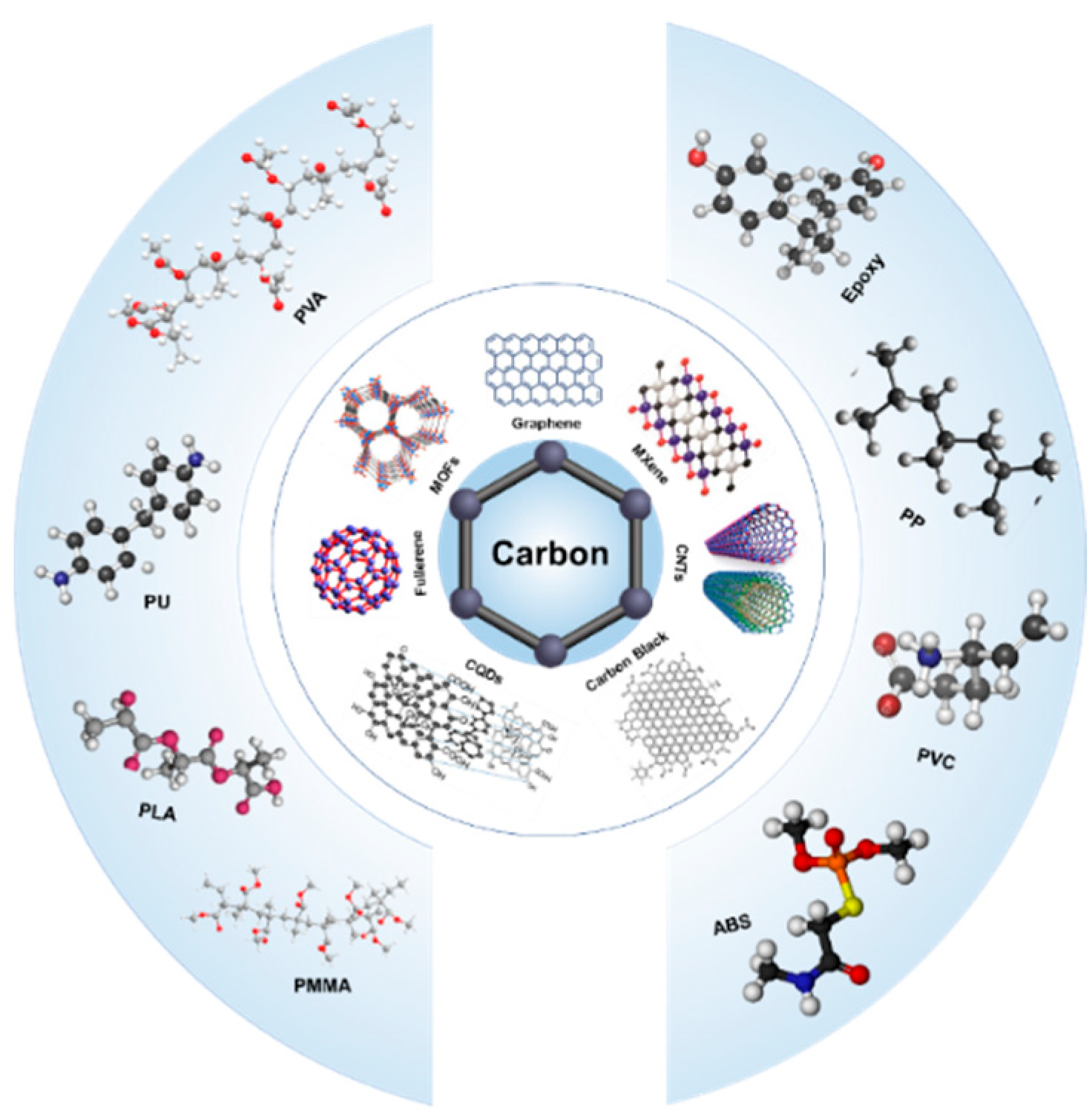
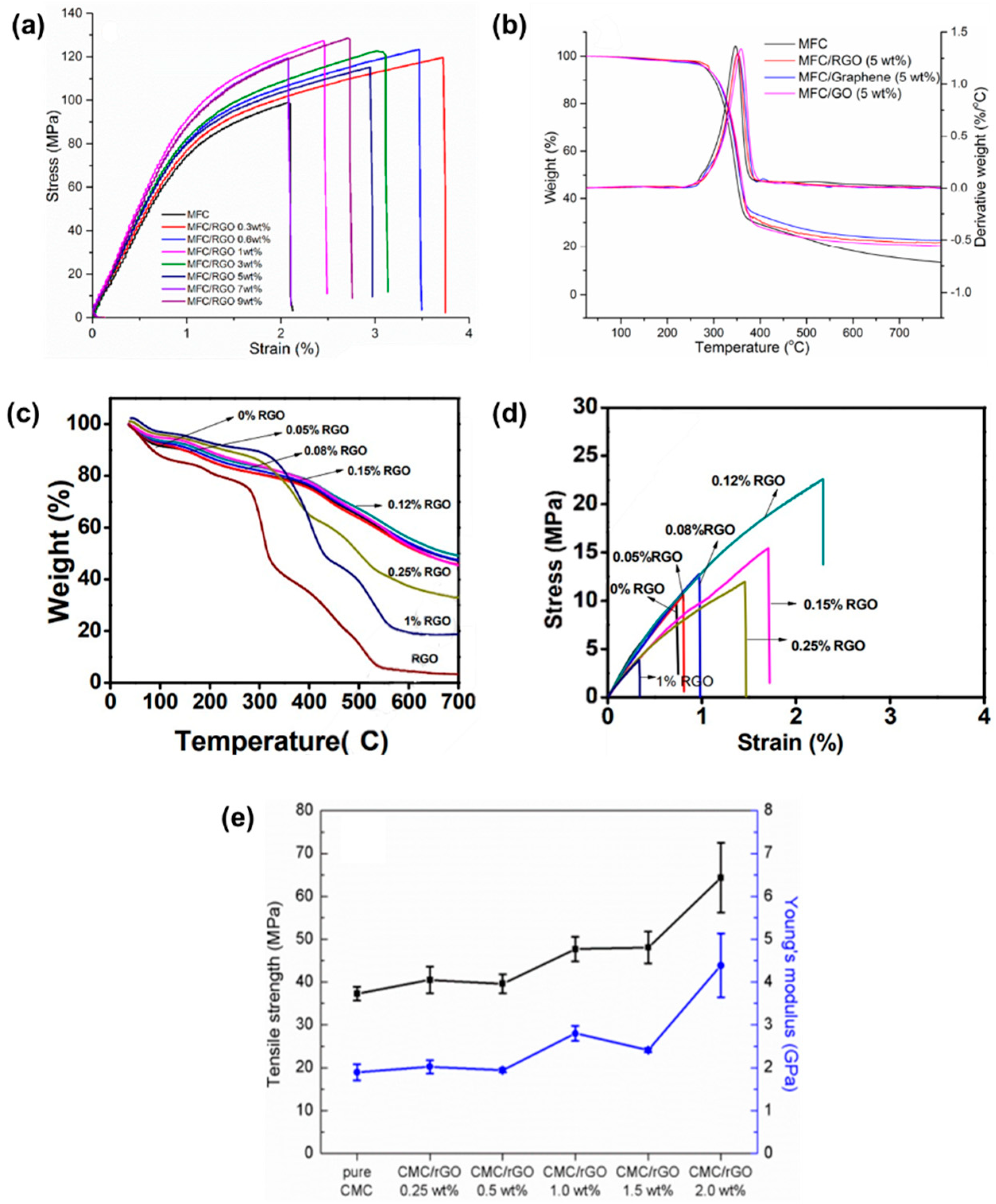
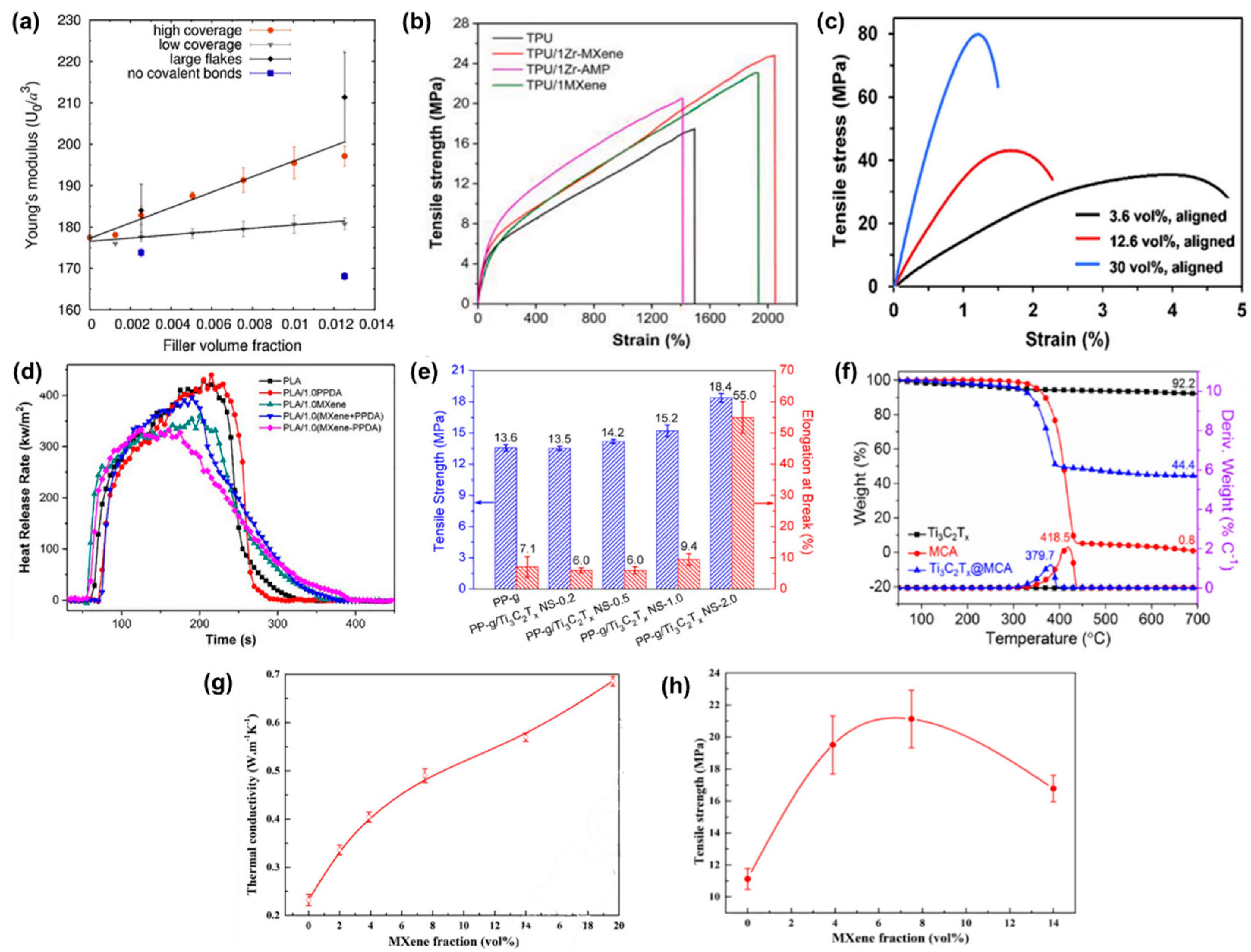
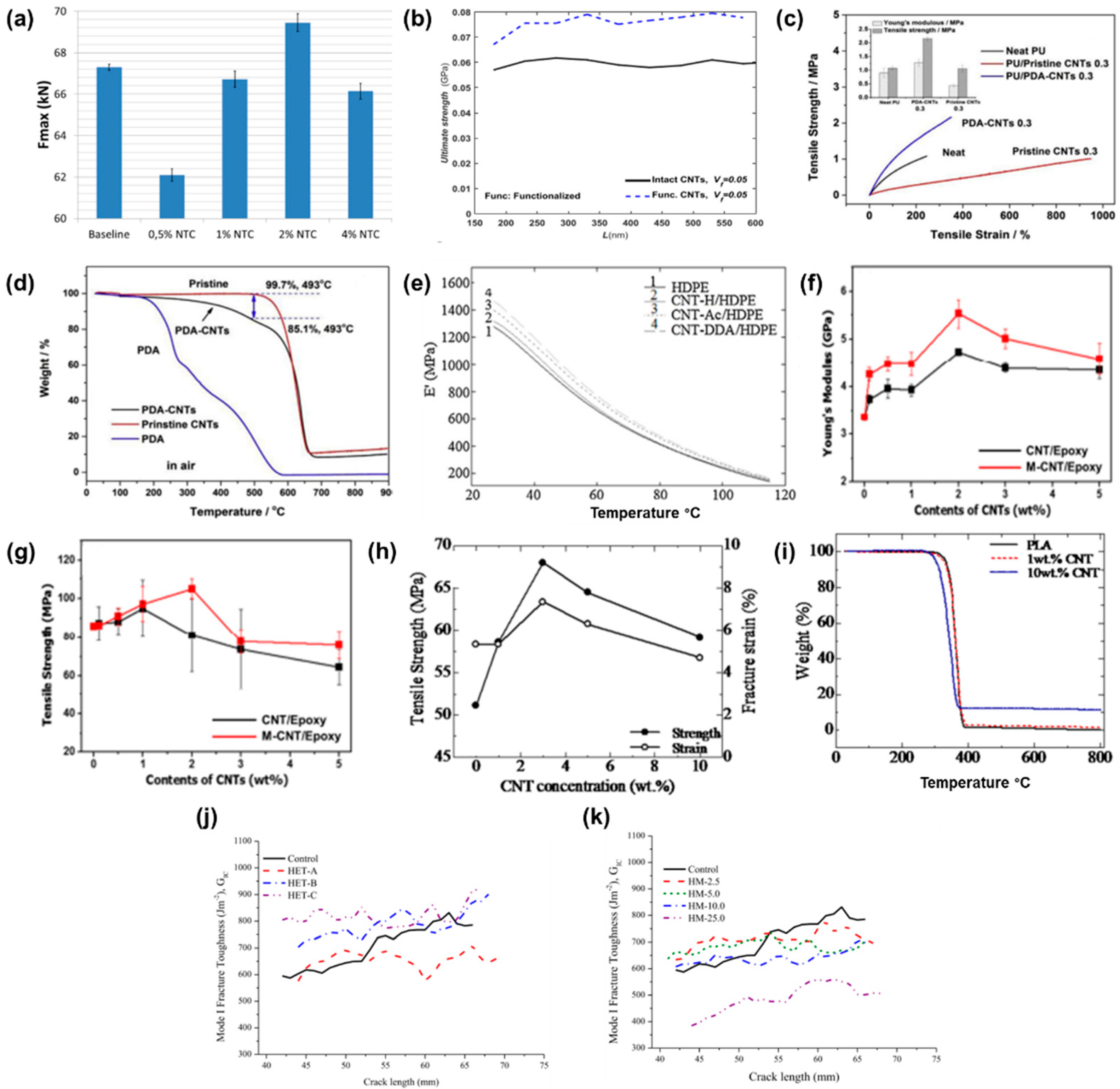

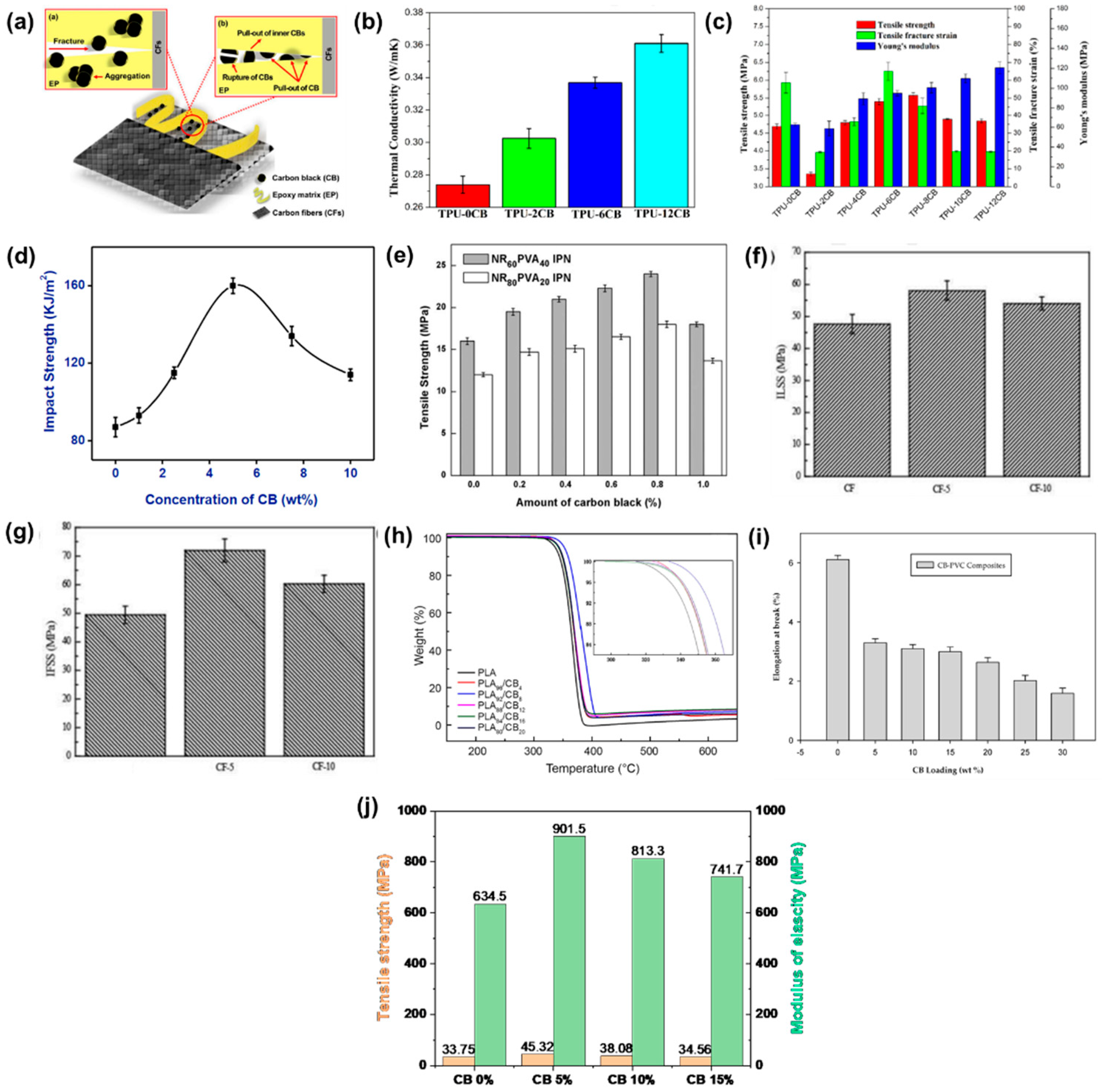
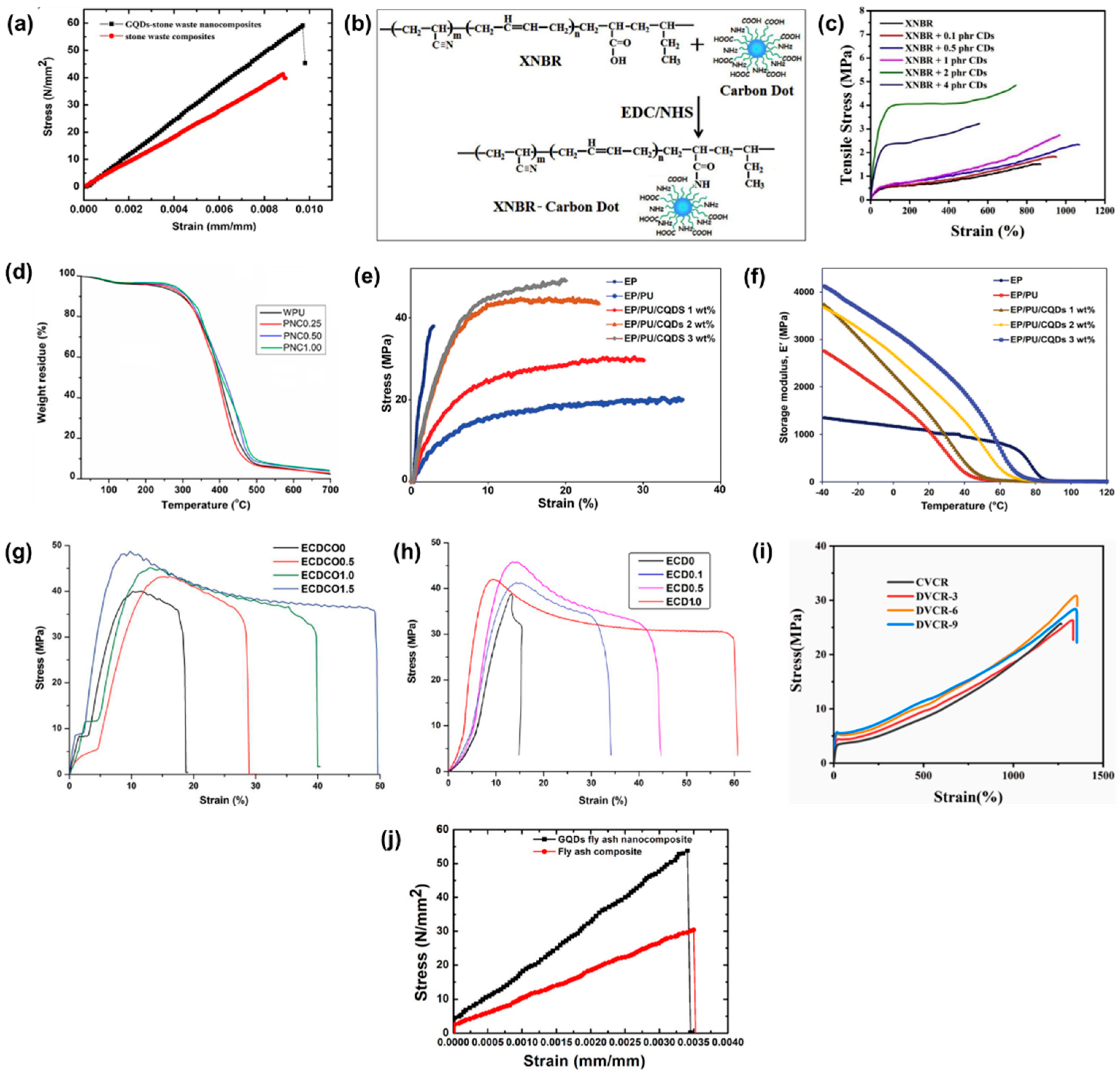
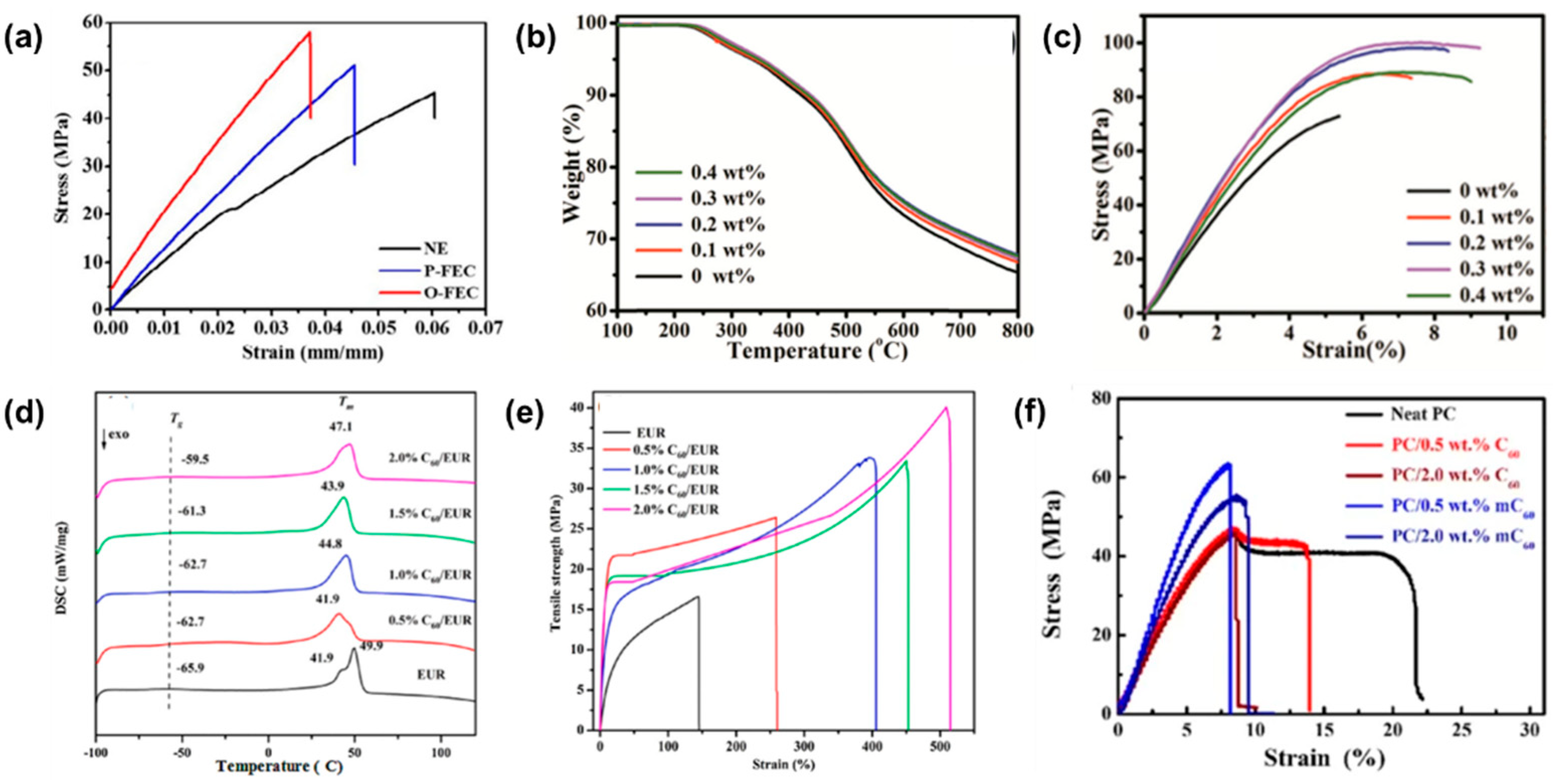

| Sr. | Polymer | Percentage | Technique | Improvement | Reference |
|---|---|---|---|---|---|
| Graphene-Based Nanocomposites | |||||
| 1 | PMMA | 1 wt.% | Bulk polymerization | Thermal properties: 126% | [21] |
| 2 | PVA | 10 wt.% | Magnetic agitation | Thermal properties: 25% | [22] |
| 3 | MFC | 0.6 wt.% | Mixing | Thermal properties: 5% Mechanical properties: 23% | [23] |
| 4 | PF | 0.12 wt.% | Mechanical stirring | Thermal properties: 12% Mechanical properties: 150% | [24] |
| 5 | CMC | 2 wt.% | Ultrasonication | Mechanical properties: 132% | [25] |
| 6 | PVDF | 2 wt.% | Stirring | N/A | [26] |
| 7 | Epoxy | 4 wt.% | Sonication | Thermal properties: 43% | [27] |
| 8 | PET/PBT | 1 wt.% | Mixing | Thermal properties: 33% Mechanical properties: 17% | [28] |
| 9 | PU | 1 wt.% | Sonication | Thermal properties: 63% Mechanical properties: 58% | [29] |
| 10 | PU | 2 wt.% | Mechanical stirring | Thermal properties: 54.5% | [33] |
| 11 | DETDA and DGEBA | 1 to 5 wt.% | Mechanical stirring | Mechanical properties: 22% | [34] |
| Sr. | Polymer | Percentage | Technique | Improvement | Reference |
|---|---|---|---|---|---|
| MXene-Based Nanocomposites | |||||
| 1 | Epoxy | 1 wt.% | Sonication | Mechanical properties: 16% | [37] |
| 2 | TPU | 1 wt.% | Stirring | Mechanical properties: 43.4% | [38] |
| 3 | PVA/epoxy | 10 wt.% | Probe Sonication | Mechanical properties: 92% | [39] |
| 4 | PLA | 1 wt.% | Mixing | Thermal properties: 23% Mechanical properties: 190% | [40] |
| 5 | PP | 2 wt.% | Mechanical stirring | Thermal properties: 79 °C Mechanical properties: 35.3% | [41] |
| 6 | TPU | 3 wt.% | Stirring | Thermal properties: 40% Mechanical properties: 62 MPa | [42] |
| 7 | NBR | 2.8 vol.% | Mechanical Stirring | Thermal properties: 180% Mechanical properties: 105% | [43] |
| 8 | TPU | 0.5 wt.% | Mixing | Mechanical properties: 47% | [45] |
| 9 | NR | 6.71 vol.% | Mixing | Mechanical properties: 155% | [46] |
| 10 | SR | 2 wt.% | Mixing | N/A | [48] |
| 11 | PVA | 1 wt.% | Mixing | Mechanical properties: 23.5% | [49] |
| Sr. | Polymer | Percentage | Technique | Improvement | Reference |
|---|---|---|---|---|---|
| Carbon-Nanotube-Based Nanocomposite | |||||
| 1 | Epoxy | 2 wt.% | Mixing | Mechanical properties: 108% | [52] |
| 2 | PU | 0.3 wt.% | Mixing | Thermal properties: 15% Mechanical properties: 40% | [54] |
| 3 | HDPE | 0.8 wt.% | Stirring | Thermal properties: 15% Mechanical properties: 15% | [55] |
| 4 | Epoxy | 2 wt.% | Centrifugal mixing | Mechanical properties: 22% | [56] |
| 5 | PLA | 3 wt.% | Mixing | Thermal properties: 2.8 folds Mechanical properties: 32.12% | [57] |
| 6 | HDPE | 0.8 wt.% | Magnetic Stirring | Thermal properties: 55 °C Mechanical properties: 43% | [59] |
| 7 | PP | 1.3 wt.% | Microwave irradiation | Thermal properties: 12% | [60] |
| 8 | PLA | 0.5 wt.% | Mixing | Mechanical properties: 41.4% | [62] |
| 9 | Epoxy | 0.5 wt.% | Mixing | Mechanical properties: 50% | [63] |
| 10 | PMMA | 0.5 wt.% | Stirring | Mechanical properties: 16% | [64] |
| 11 | Epoxy | N/A | Mixing | Mechanical properties: 32% | [65] |
| 12 | Epoxy | 0.5 wt.% | Ultrasonication | Mechanical properties: 60.16% | [66] |
| 13 | Epoxy | 0.3 wt.% | Ultrasonication | Mechanical properties: 41.2% | [67] |
| 14 | Epoxy | N/A | Mixing | Mechanical properties: 150% | [68] |
| 15 | Epoxy | 1.5 wt.% | Sonication | Mechanical properties: 28% | [69] |
| 16 | TPU | 5 wt.% | Mixing | N/A | [70] |
| 17 | Epoxy | 0.1 wt.% | Mixing | Mechanical properties: 37% | [71] |
| Sr. | Polymer | Percentage | Technique | Improvement | Reference |
|---|---|---|---|---|---|
| Carbon-Black-Based Nanocomposites | |||||
| 1 | Epoxy | 5 wt.% | Stirring | Mechanical properties: 62% | [73] |
| 2 | TPU | 12 wt.% | Co-coagulation | Thermal properties: 34% Mechanical properties: 111% | [74] |
| 3 | PP/ABS | 5 wt.% | Mixing | Mechanical properties: 88% | [75] |
| 4 | PVA | 0.8 wt.% | Stirring | Mechanical properties: 50% | [76] |
| 5 | Epoxy | N/A | Mixing | Mechanical properties: 44% | [77] |
| 6 | PLA | 8 wt.% | Melt compounding | Thermal properties: 15 °C Mechanical properties: 45% | [78] |
| 7 | PVC | 15 wt.% | Mixing | Mechanical properties: 60% | [79] |
| 8 | Epoxy | 5 wt.% | Magnetic Stirring | Mechanical properties: 32% | [80] |
| 9 | Vinyl ester | 4 wt.% | Ultrasonication | Mechanical properties: 33% | [81] |
| 10 | NR/SBR/NBR | 45 parts per hundred of the rubber (phr) | Mixing | Mechanical properties: 233% | [82] |
| 11 | EPDM | 0.5 wt.% | Vulcanization | Thermal properties: 28% | [84] |
| 12 | NR | N/A | Vulcanization | Thermal properties: 4% | [85] |
| Sr. | Polymer | Percentage | Technique | Improvement | Reference |
|---|---|---|---|---|---|
| Carbon-Quantum-Dot-Based Nanocomposites | |||||
| 1 | Polyester | 5 wt.% | Mixing | Mechanical properties: 62% | [87] |
| 2 | Epoxy/PU | 1–3 wt.% | Mixing | Mechanical properties: 32% | [88] |
| 3 | PEO | N/A | Mixing | Mechanical properties: 157% | [89] |
| 4 | Stone waste | N/A | Mixing | Mechanical properties: 58% | [90] |
| 5 | XNBR | 2 phr | Stirring | Thermal properties: 40 °C Mechanical properties: 161% | [91] |
| 6 | WPU | 1 wt.% | Mixing | Thermal properties: 12% Mechanical properties: 89% | [92] |
| 7 | Epoxy/PU | N/A | Mixing | Mechanical properties: 150% | [97] |
| 8 | Epoxy | 1.5 wt.% | Magnetic Stirring | Thermal properties: 23 °C Mechanical properties: 20% | [94] |
| 9 | Epoxy | 0.5 wt.% | Magnetic Stirring | Mechanical properties: 21% | [98] |
| 10 | CR | N/A | Melt-blending | Mechanical properties: 460% | [99] |
| 11 | Epoxy | N/A | Mixing | Mechanical properties: 120% | [100] |
| 12 | PLA | N/A | Mixing | Mechanical properties: 66% | [101] |
| 13 | PAN | 1 wt.% | Stirring | Mechanical properties: 7 folds | [93] |
| 14 | TPU | 1 wt.% | Stirring | Mechanical properties: 57% | [95] |
| 15 | Poly (acrylic acid-co-meth acrylamide) | 2 wt.% | Stirring | N/A | [96] |
| Sr. | Polymer | Percentage | Technique | Improvement | Reference |
|---|---|---|---|---|---|
| Fullerene Based Nanocomposites | |||||
| 1 | Epoxy | 0.5 wt.% | Mechanical stirring | Mechanical properties: 23% | [102] |
| 2 | PA | 0.3 wt.% | Sonication | Thermal properties: 12 °C Mechanical properties: 43% | [103] |
| 3 | EUR | 2 wt.% | Stirring | Thermal properties: 12.5% Mechanical properties: 67% | [104] |
| 4 | PC | 1 wt.% | Stirring | Mechanical properties: 33% | [105] |
| 5 | SPEI | 0.5 wt.% | Magnetic stirring | Mechanical properties: 114% | [106] |
| 6 | PMMA | N/A | Mixing | Mechanical properties: 25% | [107] |
| 7 | PVDF | 0.5 wt.% | Electrical stirring | Thermal properties: 14% | [109] |
| Sr. | Polymer | Percentage | Technique | Improvement | Reference |
|---|---|---|---|---|---|
| Metal–Organic Framework-Based Nanocomposites | |||||
| 1 | PLLA | 2 wt.% | Mixing | Mechanical properties: 37% | [111] |
| 2 | Epoxy | 2.5 wt.% | Mixing | Mechanical properties: 37% | [113] |
| 3 | PEO | 15 wt.% | Mixing | Thermal properties: 180% Mechanical properties: 426% | [115] |
| 4 | PVA | 2 wt.% | Stirring | Thermal properties: 33 °C Mechanical properties: 32% | [116] |
| 5 | Epoxy | 2 wt.% | Sonication | Mechanical properties: 42% | [117] |
| 6 | CA | 7 wt.% | Stirring | Thermal properties: 5% Mechanical properties: 43% | [118] |
| 7 | PLA | 1 wt.% | Stirring | Mechanical properties: 42% | [119] |
| 8 | SBR | 10 phr | Mixing | Mechanical properties: 130% | [120] |
Disclaimer/Publisher’s Note: The statements, opinions and data contained in all publications are solely those of the individual author(s) and contributor(s) and not of MDPI and/or the editor(s). MDPI and/or the editor(s) disclaim responsibility for any injury to people or property resulting from any ideas, methods, instructions or products referred to in the content. |
© 2023 by the authors. Licensee MDPI, Basel, Switzerland. This article is an open access article distributed under the terms and conditions of the Creative Commons Attribution (CC BY) license (https://creativecommons.org/licenses/by/4.0/).
Share and Cite
Latif, Z.; Ali, M.; Lee, E.-J.; Zubair, Z.; Lee, K.H. Thermal and Mechanical Properties of Nano-Carbon-Reinforced Polymeric Nanocomposites: A Review. J. Compos. Sci. 2023, 7, 441. https://doi.org/10.3390/jcs7100441
Latif Z, Ali M, Lee E-J, Zubair Z, Lee KH. Thermal and Mechanical Properties of Nano-Carbon-Reinforced Polymeric Nanocomposites: A Review. Journal of Composites Science. 2023; 7(10):441. https://doi.org/10.3390/jcs7100441
Chicago/Turabian StyleLatif, Zeeshan, Mumtaz Ali, Eui-Jong Lee, Zakariya Zubair, and Kang Hoon Lee. 2023. "Thermal and Mechanical Properties of Nano-Carbon-Reinforced Polymeric Nanocomposites: A Review" Journal of Composites Science 7, no. 10: 441. https://doi.org/10.3390/jcs7100441
APA StyleLatif, Z., Ali, M., Lee, E.-J., Zubair, Z., & Lee, K. H. (2023). Thermal and Mechanical Properties of Nano-Carbon-Reinforced Polymeric Nanocomposites: A Review. Journal of Composites Science, 7(10), 441. https://doi.org/10.3390/jcs7100441







